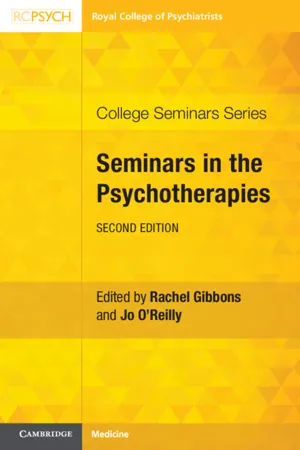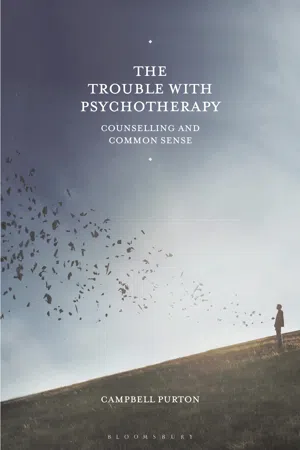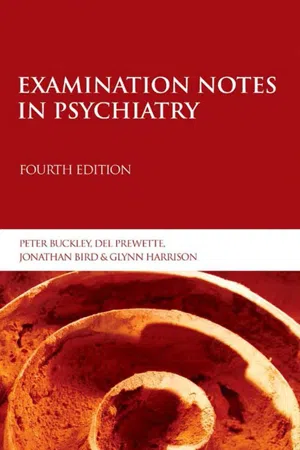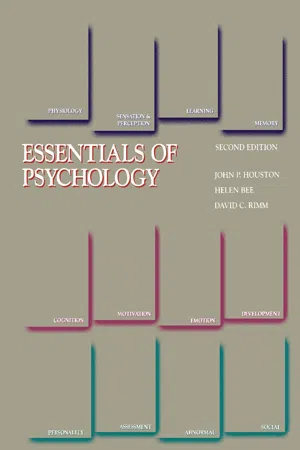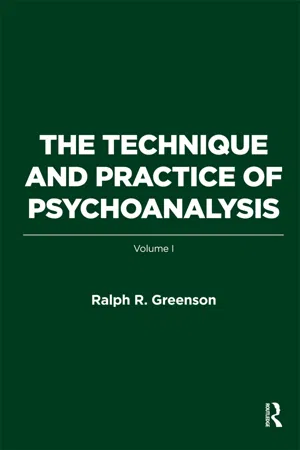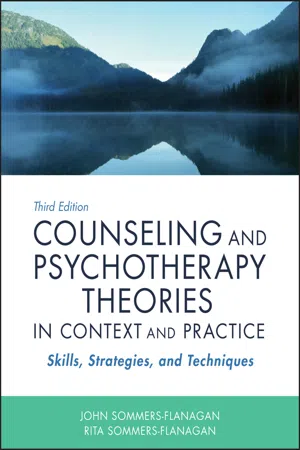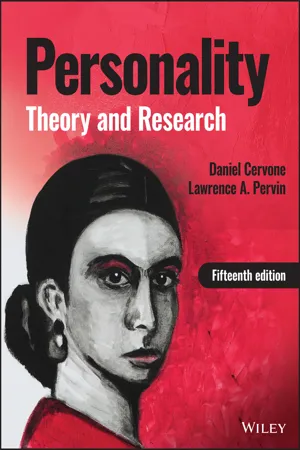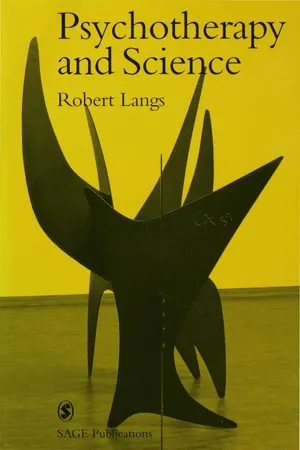Psychology
Psychoanalytic Therapy
Psychoanalytic therapy is a form of psychological treatment based on Sigmund Freud's psychoanalytic theory. It aims to explore unconscious conflicts and unresolved issues that may be causing emotional distress or behavioral problems. Through techniques such as free association and dream analysis, this therapy seeks to bring repressed thoughts and feelings to the conscious mind, leading to insight and healing.
Written by Perlego with AI-assistance
Related key terms
1 of 5
12 Key excerpts on "Psychoanalytic Therapy"
- Gerald Corey(Author)
- 2020(Publication Date)
- Cengage Learning EMEA(Publisher)
All Rights Reserved. May not be copied, scanned, or duplicated, in whole or in part. Due to electronic rights, some third party content may be suppressed from the eBook and/or eChapter(s). Editorial review has deemed that any suppressed content does not materially affect the overall learning experience. Cengage Learning reserves the right to remove additional content at any time if subsequent rights restrictions require it. PSYCHOANALY TIC THERAPY 67 (Wolitzky, 2011a). Two goals of Freudian Psychoanalytic Therapy are to make the unconscious conscious and to strengthen the ego so that behavior is based more on reality and less on instinctual cravings or irrational guilt. Successful analysis is believed to result in significant modification of the individual’s personality and character structure. Therapeutic methods are used to bring out unconscious mate- rial. Then childhood experiences are reconstructed, discussed, interpreted, and ana- lyzed. It is clear that the process is not limited to solving problems and learning new behaviors. Rather, there is a deeper probing into the past to develop the level of self-understanding that is assumed to be necessary for a change in character. Psychoanalytic Therapy is oriented toward achieving insight, but not just an intel- lectual understanding; it is essential that the feelings and memories associated with this self-understanding be experienced. Therapist’s Function and Role In classical psychoanalysis, analysts typically assume an anonymous non- judgmental stance, which is sometimes called the “blank-screen” approach. They avoid self-disclosure and maintain a sense of neutrality to foster a transference relationship, in which their clients will make projections onto them.- eBook - PDF
- Rachel Gibbons, Jo O'Reilly(Authors)
- 2021(Publication Date)
- Cambridge University Press(Publisher)
Part I Therapy Theory and Practice Section 1 Psychodynamic Psychotherapy Chapter 1 Psychodynamic Theory: The Development of a Model of the Mind Jo O’Reilly This chapter aims to describe the key contributions that psychoanalytic theory has made to our understanding of the mind. The practice of psychiatry and the development of psychological treatments rest upon how we understand the mind and emotional life. As clinicians working with patients with difficulties in how they feel, relate and think we need an understanding of psychic life in healthy and more disturbed states, just as practitioners of physical medicine need to understand bodily processes in sickness and in health. Since the late nineteenth century psychoanalytic theory has provided a platform from which a series of models of the mind have evolved. An underlying and fundamental tent of this approach is that most of mental functioning occurs at an unconscious level; a finding now widely supported within psychology and neuroscience [1]. The unique contributions of a psychoanalytic approach seek to elucidate and to understand the form and nature of these unconscious processes, both in healthy and more disturbed states of mind. Furthermore, clinical techniques derived from psychoanalysis such as free associ- ation and dream interpretation are specifically aimed at identifying unconscious mental processes and psychoanalysis has a great deal to offer a systematic study of the uncon- scious. Although the terms psychodynamic or psychoanalytic tend to be used in associ- ation with psychotherapeutic treatment, a psychoanalytic approach refers to a school of thought able to provide insights into the workings of the mind far beyond the treatment approaches derived from it. The limits of rational thought and considered volitional action in explaining emotional life are blindingly evident from the complexities, extremities and non-common-sensical nature of much of human behaviour. - eBook - PDF
- Danny Wedding, Raymond Corsini(Authors)
- 2018(Publication Date)
- Cengage Learning EMEA(Publisher)
| 21 2 Psychodynamic Psychotherapies Jeremy D. Safran, Alexander Kriss, and Victoria Kaitlin Foley Learning Objectives 1 Explain the basic principles that tend to cut across the different psychoanalytic perspectives, and be able to identify how they emerge within each tradition. 2 Describe the social, political, cultural, and historical forces that contextualize the public reception of psychoanalytic practices over time, and explain why it is difficult to compare psychoanalysis to other systems of psychotherapy. 3 Trace the development of psychoanalytic thinking from classical Freudian psychoanalysis to the contemporary psychoanalytic traditions. 4 Describe the significance of the therapeutic alliance in modern psychoanalytic and psychodynamic psychotherapy, and explain how basic principles (e. g. transference, countertransference, fantasy) manifest within alliance-focused practices. 5 Describe the typical process of contemporary psychoanalytic psychotherapy, noting its characteristic features, stages, mechanisms, and interventions. 6 Review the Case Study of “Ruth,” and attempt to tease out the ways in which the various psychoanalytic principles and practices manifest in her therapy. Sigmund Freud (1856–1939) Bettmann/Getty Images Carl Jung (1875–1961) INTERFOTO/Alamy Stock Photo Copyright 2019 Cengage Learning. All Rights Reserved. May not be copied, scanned, or duplicated, in whole or in part. Due to electronic rights, some third party content may be suppressed from the eBook and/or eChapter(s). Editorial review has deemed that any suppressed content does not materially affect the overall learning experience. Cengage Learning reserves the right to remove additional content at any time if subsequent rights restrictions require it. 22 | Chapter 2 Overview LO1 Psychoanalysis is a distinctive form of psychological treatment and a model of psychologi-cal functioning, human development, and psychopathology. - eBook - PDF
The Trouble with Psychotherapy
Counselling and Common Sense
- Campbell Purton(Author)
- 2014(Publication Date)
- Bloomsbury Academic(Publisher)
Accounts of psychodynamic therapy are inevitably framed in terms of the basic concepts of psychoanalysis, such as those of ‘the unconscious’ and ‘repression’. I will discuss these shortly, but first I will try to describe simply what psychodynamic therapists do , and con-sider to what extent their practices can be understood without appeal to the theoretical notions that lie in the background. This is not altogether an easy task; the philosopher Alistair MacIntyre (2004, p. 51) remarks in connection with psychoanalysis: Freud’s own descriptions of the analytic process are all coloured by the fact that at the time that he was developing it he was also developing his own theoretical concepts; so that he rarely, if ever, gives a purely descriptive account of psychoanalysis. The common-sense core Nevertheless, it is worth trying to describe what in practice is done in psychoanalysis, and MacIntyre (p. 52) offers the following: In psychoanalysis the patient talks, saying whatever it occurs to him to say. In thus talking he will in fact tend to dwell on some subjects rather than on others, he will pass by some topics and continually return to others. When he dwells on some topic or when he displays great emotion the analyst will tend to suggest an interpretation to him of what he is saying. The more the analysis progresses the more the patient will pass from talk about adult life to talk about childhood, and incidents that had apparently been forgotten will be recalled. This recalling will in turn be accompanied by emotional release. Such emotional release will in turn be followed by a mitigation of the neurotic symptoms which were the occasion of undertaking psychoanalytic treatment. 81 - eBook - PDF
- Peter Buckley, Del Prewette, Jonathan Byrd, Glynn Harrison(Authors)
- 2004(Publication Date)
- CRC Press(Publisher)
Psychotherapy 23 GENERAL ASPECTS Psychotherapy is the development of a trusting relationship, which allows free com-munication and leads to understanding, integration and acceptance of self. COMMON FEATURES OF PSYCHOTHERAPIES (JEROME FRANK) 1 An intense, emotionally charged relationship with a person or group. 2 A rationale or myth explaining the distress and methods of dealing with it. 3 Provision of new information about the future, the source of the problem and pos-sible alternatives which hold a hope of relief. 4 Non-specific methods of boosting self-esteem. 5 Provision of success experiences. 6 Facilitation of emotional arousal. 7 Takes place in a locale designated as a place of healing. DIFFERING LEVELS OF PSYCHOTHERAPY Informal As between friends and relatives and in self-help groups. Formal • Supportive – to restore or maintain the status quo. Useful in: – Those in crisis for whom change is not desired. – The emotionally severely handicapped who are not expected to improve greatly. • Dynamic – to effect change in the individual. Uses: – Confrontation of defences. – Clarification. – Interpretations – new formulations of problems. PSYCHOANALYSIS DEFINITIONS AND KEY TERMS • Psychoanalysis – both (i) a psychological theory of the mind and (ii) a psychothera-peutic treatment method. • Libido – now used to mean overall mental ‘energy’ or drive. • Love object – person or thing towards which the libido is directed (or ‘cathected’). • Actual neurosis – caused by physical damming-up of sexual urges (e.g. neurasthenia). • Psychoneurosis – caused by psychological damming-up of fundamental instinctive urges in a conflict situation (e.g. hysteria). • Dream work – the process which turns the hidden ‘latent dream thoughts’ into the reported ‘manifest content of the dream’. It consists of: – Condensation – the manifest content shows ‘over-determinism’. – Displacement. – Dramatization. – Symbolization. – Secondary elaboration. - eBook - PDF
- John P. Houston, Helen Bee, David C. Rimm(Authors)
- 2013(Publication Date)
- Academic Press(Publisher)
426 Chapter 1 3 Treating psychological problems usually, the total treatment is more brief than in classical psychoanalysis. The relationship between client and therapist is less intense and somewhat less structured. It is more like a typical human interaction than the classi-cal psychoanalytic situation. Classical psychoanalysis focuses almost exclu-sively on the remote past. Psychoanalytic psychotherapy is more likely to deal with here-and-now issues and emphasize problem solving. In this respect, psychoanalytic psychotherapy forms a bridge between classical psychoanalysis, with its total emphasis on insight, and some of the more recent action-oriented therapies we will discuss shortly, such as Gestalt therapy and behavior therapy. We have not mentioned psychoses because psychoanalysis is mainly a therapy about the origin and treatment of neuroses. Freudians see psycho-ses as severe regressions to very early stages of development, but they do not believe psychoanalysis is useful in dealing with psychotic patients (Fine, 1973). Evaluation of psychoanalysis Proponents of psychoanalytic approaches argue that only psychoanalysis provides a complete explanation of human personality. They point to clinical case histories (Luborsky, 1970; Feldman, 1968), as well as some controlled experimentation (Meltzoff & Kornreich, 1970), to support the efficacy of treatment. Critics of psychoanalysis argue that the basic con-cepts are vague and are very hard to test or measure objectively (Bandura, 1969). They also point out that because of the large number of treatment sessions required, psychoanalysis is priced well beyond the reach of most people—an analysis can easily cost $50,000. Some critics even argue that psychoanalysis and similar approaches are no more effective than no treat-ment at all (Eysenck, 1965; Meltzoff & Kornreich, 1970), though others dispute these findings. - Sarah Rundle(Author)
- 2013(Publication Date)
- Academic Press(Publisher)
CHAPTER 13: TREATING PSYCHOLOGICAL PROBLEMS 1. When Alice visits her therapist, she free associates and tells him about her dreams or about her childhood experiences. Her therapist is a a. client-centered therapist. c. Gestalt therapist. b. cognitive behavior therapist. *d. psychoanalyst, (p. 422). 2. When Bob visits his therapist, the therapist tries to help him understand how he feels about himself and others. The therapist does not make judgments concerning his thoughts or behavior, but he reminds Bob occasionally that he is responsible for them. Bob's therapist is a *a. client-centered therapist, (p. 422). c. behavioral psychologist. b. psychoanalyst. d. cognitive behavior therapist. 3. Tina went to a therapist because she is timid and often feels tense and anxious. Her therapist helped her to learn to express her feelings clearly and without anger or tears and helped her get rid of an unreasonable fear she had. Tina's therapist is a a. psychoanalyst. c. Gestalt psychologist. b. Rogerian psychologist. *d. behavioral psychologist, (p. 422). A PSYCHODYNAMIC APPROACH: PSYCHOANALYSIS 4. The central concept in psychoanalytic theory is *a. the unconscious, (p. 42 3) c. catharsis. b. libido. d. transference. 5. Freud's specialty as a medical doctor was a. gynecology. c. brain surgery. b. ophthalmology. *d. neurology, (p. 422) 6. It has been suggested that watching aggression and violence on TV is good for us because it helps us release pent-up emotions in a harmless way. This is called the hypothesis. a. dynamic c. transference *b. catharsis (p. 422) d. vicarious aggression 7. When a psychoanalyst talks about the dynamics of personality, she is referring to a. any aspect of personality that changes over time. b. processes, as opposed to static structures. c. the way in which the ego satisfies the demands of the id. *d. unconscious motivation, (p. 423) 193 194 CHAPTER 13 8. An individual with a strong sex drive is.- eBook - PDF
- Ralph R. Greenson(Author)
- 2018(Publication Date)
- Routledge(Publisher)
The art of psy-choanalytic technique as it is used in classical psychoanalysis is based on the blending of the analytic with the nonanalytic proce-dures. It is hard to teach. The principles of psychoanalytic tech-niques are more readily teachable. In these volumes I intend to focus primarily on the basic components of so-called classical psy-choanalytic technique. 1.4 Indications and Contraindications for Psychoanalytic Therapy: A Preliminary View The problem of determining the indications and contraindica-tions for psychoanalytic treatment hinges on two separate but related issues. The first and most important question we have to answer is: Is the patient analyzable? The second and contingent question is: Will psychoanalytic treatment best serve the patient's needs? I would like to amplify this latter issue by a clinical example. Let us assume you have a patient who desires psychotherapy and you believe he is able to work effectively and well in the ana-lytic situation. Would you advise him to undertake psychoanalysis if you discover that he is about to be drafted into the armed forces? Psychoanalysis is a long-term treatment, ordinarily requiring three to five years of time. The total life situation must be considered in evaluating whether or not you would recommend this form of psychotherapy. The problem of analyzability is a complex one because it depends on many different qualities and traits of the patient, both healthy and pathological. Furthermore, it is also necessary to be thoroughly familiar with the many exacting demands that the psychoanalytic process and procedure make on the patient. The brief summary of theory and technique thus far presented permits us only a prelimi-nary view. We shall have to postpone a more definitive discussion until the later chapters. Freud ( 1905a) recognized quite early that single criteria, no matter how important or clear-cut, do not permit an accurate pre- 52 SURVEY OF BASIC CONCEPTS diction of a patient's analyzability. - eBook - PDF
Counseling and Psychotherapy Theories in Context and Practice
Skills, Strategies, and Techniques
- John Sommers-Flanagan, Rita Sommers-Flanagan(Authors)
- 2018(Publication Date)
- Wiley(Publisher)
Although the analyst’s per-spective is important, the method involves asking clients to free associate to their dreams, thus facilitating a col-laborative exploration. Psychodynamic Psychotherapy in Action: Brief Vignettes In traditional psychoanalysis, psychological defenses are interpreted before the underlying conflicts. If you inter-pret the underlying conflict first, clients will use preexisting defense mechanisms (e.g., denial) to resist the interpre-tation. For example, if you tell your client that the rea-son for her silence is fear of rejection, then she’s likely to withdraw by using more silence. Instead, if you inter-pret the defense first, by opening up a discussion of how she uses silence to protect herself, then she may be able to begin being more open, giving you a clearer glimpse of underlying conflicts. She may then be more able to understand and accept deeper conflict interpretations. Vignette I: A Poor Application of Interpretation Defenses don’t promptly disappear when interpreted. In fact, especially when used in an authoritarian or confron-tational manner, interpretations can produce defensive Dream Interpretation Freud considered dreams as “the via regia [royal road] to a knowledge of the unconscious.” He used dream inter-pretation to explain to clients the psychological meaning of their dream symbols. Client dreams were the best access route he could find for identifying repressed, unconscious, instinctual drives. Unfortunately, as it turns out, Freud’s royal road is fraught with potholes and speed bumps. Although dreams provide access to the unconscious, similar to client free association material, they consist of unconscious derivatives. To achieve insight, psychoana-lysts must interpret the dreams’ meanings. This can be problematic because psychoanalysts may project their own issues onto their clients’ ambiguous dream symbols. - eBook - PDF
Personality
Theory and Research
- Daniel Cervone, Lawrence A. Pervin(Authors)
- 2022(Publication Date)
- Wiley(Publisher)
How- ever, for financial reasons, including the need to support a family, Freud abandoned his research career and became a practicing physician. In his therapeutic work, Freud encountered patients with physical symptoms that had no obvi- ous physical causes. He explored the possibility that the symptoms had psychological causes. To unearth them, he needed a therapy method. He tried hypnosis, which he learned from the renowned French psychiatrist Jean Charcot. It was promising, but there was a problem: not all patients could be hypnotized. Freud therefore devised an alternative known as the free associa- tion method; patients are encouraged to let their thoughts run free, without inhibition. The free flow of thoughts, Freud believed, would reveal hidden causes of patients’ observable problems. Free association was both a therapy and a scientific method; his patients’ free associations were Freud’s primary evidence for his personality theory. In 1897, the year following his father’s death, Freud was simultaneously depressed and anxious. To understand his problems, Freud began an activity that proved utterly fundamen- tal to the development of psychoanalysis: a self-analysis. Freud analyzed the contents of his experiences, including his dreams, which he thought would reveal unconscious thoughts and desires. He continued this self-analysis throughout his life, devoting to it the last half hour of each workday. Freud incorporated insight from this self-analysis into The Interpretation of Dreams (Freud, 1900). In this book, Freud widened his aims. He was no mere therapist. He was developing a theory of mind—an overall conception of mental structures and processes. The book sold few copies at first, but today it stands as a classic. Freud overcame personal challenges, advanced his theorizing, and gradually achieved wide- spread recognition. Lectures in the United States in 1909 greatly enhanced his profile outside of Europe. - Diane Gehart(Author)
- 2015(Publication Date)
- Cengage Learning EMEA(Publisher)
The best and most rigorously researched psychodynamic approaches are the brief psy-chodynamic methods, many of which are recognized as evidence-based approaches by the U.S. National Institutes of Health (Luborsky et al., 2008; Weissman, Markowitz, & Klerman, 2000, 2007). The strongest support for the effectiveness of general psychody-namic counseling comes from large-scale studies comparing psychodynamic to other approaches such as cognitive-behavioral and humanistic, as was recently done in the United Kingdom, indicating no significant difference in outcome between theories (Stiles, Barkham, Mellor-Clark, & Connell, 2008). More recent studies show a trend for sus-tained gains and even increasing gains after counseling has ended (Abbass, Hancock, Henderson, & Kisely, 2006; Leichsenring, 2009). In addition, there is support for spe-cific psychodynamic concepts. For example, using the Core Conflictual Relationship Theme, Luborsky and associates (Luborsky et al., 2008; Luborsky & Crits-Christoph, 1998, Luborksy & Luborksy, 2006) have researched and found evidence that supports the psychoanalytic concept of transference. Additional research is needed to compare the different models or schools of psychodynamic theory to determine if they vary in effectiveness generally or for specific issues (Leichsenring, 2009). Finally, newer areas of research in psychodynamic counseling focus on the neurological and physiological corre-lates of psychodynamic processes and inform new ways of conceptualizing unconscious process and attachment (Marci & Riess, 2009; Roffman, & Gerber, 2009). 60 CHAPTER 3 • Psychoanalytic and Psychodynamic Counseling and Psychotherapy Copyright 2016 Cengage Learning. All Rights Reserved. May not be copied, scanned, or duplicated, in whole or in part. Due to electronic rights, some third party content may be suppressed from the eBook and/or eChapter(s).- eBook - PDF
- Robert Langs(Author)
- 1999(Publication Date)
- SAGE Publications Ltd(Publisher)
A CLINI CAL ILLUSTRAT ION The following clinical excerpt will help us to appreciate the differences between these three psychoanalytic approaches. It is drawn from the psychoanalytic literature but fully disguised. The material was offered by its author, a classica lly trained psychoanalyst, to illustrate the importance of flexibility with the ground rules of psychotherapy. This position was 30 Psychotherapy and Science developed on the basis of a listening-fo n nulati ng process that considers only manifest contents and their evident implications in deriving uncon-scious meaning from patients' material. This methodology has been adopted by both the Freudian and Jungian camps, but is seen as incom-plete and unreliable by the communicative approach. Ms Brent was in once-weekly psychotherapy with Dr May because of intennittent episodes of depression caused by unsatisfactory relationships with men and by her · diff icult ies in find ing satisfaction in her work as an attorney. The patient began the session that we wil l consider by mentioning that she felt physically ill and should be at home in bed. The therapist, concerned about the patient's physical state, of fered her his thermometer so she could take her temperature, but she refused. The patient went on to mention an outrageous client who had become aggressive sexually toward her, at one point trying to force her to kiss him and attempting to fondle her breasts. She had pushed him off and had warned him that if he tried to do anything like that again, she would withdraw as his attorney. Insensitive to her rejection, he reacted by pressing her to accept a bracelet he had bought for her -that too she rejected. The incident recalled an episode with her father wh::n she was in her early twenties, soon after her mother had died. Her father wanted his daughter to share his bed with him because he was having panic attacks while sleeping alone. She had refused him and had left home within months of that incident.
Index pages curate the most relevant extracts from our library of academic textbooks. They’ve been created using an in-house natural language model (NLM), each adding context and meaning to key research topics.

